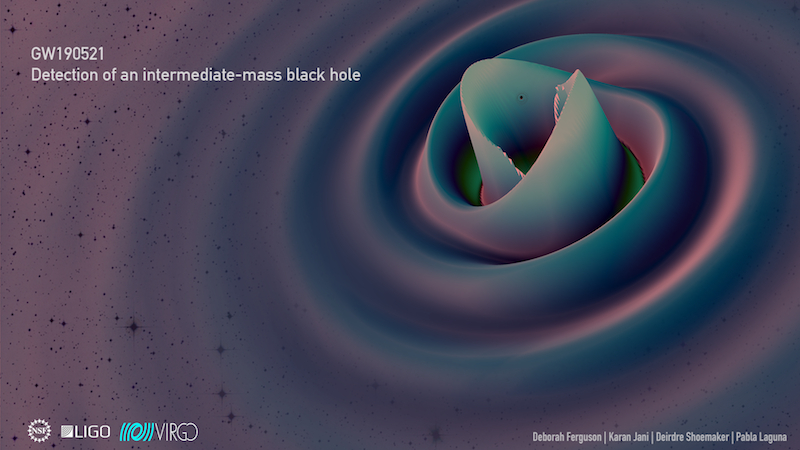
Scientists have discovered gravitational waves stemming from a black hole merger event that suggest the resultant black hole settled into a stable, spherical shape. These waves also reveal the combo black hole may be much larger than previously thought.
When initially detected on May 21, 2019, the gravitational wave event known as GW190521 was believed to have come from a merger between two black holes, one with a mass equivalent to just over 85 suns and the other with a mass equivalent to about 66 suns. Scientists believed the merger therefore created an approximately 142 solar mass daughter black hole.
Yet, newly studied spacetime vibrations from the merger-created black hole, rippling outward as the void resolved into a proper spherical shape, seem to suggest it's more massive than initially predicted. Rather than possess 142 solar masses, calculations say it should have a mass equal to around 250 times that of the sun.
These results could ultimately help scientists better test general relativity, Albert Einstein's 1915 theory of gravity, which first introduced the concept of gravitational waves and black holes. “We are really exploring a new frontier here," Steven Giddings, a theoretical physicist at the University of California, said in a statement.
Related: How dancing black holes get close enough to merge
Gravitational waves and general relativity
General relativity predicts that objects with mass warp the very fabric of space and time — united as a single, four-dimensional entity called "spacetime”" — and that "gravity" as we perceive it arises from the curvature itself.
Just as a bowling ball placed on a stretched rubber sheet causes a more extreme "dent" than a tennis ball would, a black hole causes more curvature in spacetime than a star does, and a star causes more curvature than a planet does. In fact, a black hole, in general relativity, is a point of matter so dense it causes curvature of spacetime so extreme that, at a boundary called the event horizon, not even light is fast enough to escape the inward dent.
This isn't the only revolutionary prediction of general relativity, however. Einstein also predicted that when objects accelerate, they should set the very fabric of spacetime ringing with ripples called gravitational waves. And again, the more massive the objects involved, the more extreme the phenomenon is. This means when dense bodies like black holes spiral around one another, constantly accelerating due to their circular motion, spacetime rings around them like a struck bell, humming with gravitational waves.
These ripples in spacetime carry away angular momentum from the spiraling black holes, and that, in turn, causes the black holes' mutual orbits to tighten, drawing them together and increasing the frequency of the gravitational waves emitted. Spiraling closer and closer, the black holes finally merge, creating a daughter black hole and sending a high-frequency "chirp" of gravitational waves echoing out through the cosmos.
But there was one thing Einstein got wrong about gravitational waves. The great physicist believed that these ripples in spacetime would be so faint that they would never be detected here on Earth after traveling across the universe for millions, or even billions, of light years.
Yet, in Sept. 2015, the twin detectors of the Laser Interferometer Gravitational-Wave Observatory (LIGO) based in Washington and Louisiana showed Einstein was incorrect. They detected GW150914, gravitational waves associated with merging black holes located around 1.3 billion light-years away. The gravitational wave signal was detected as a change in the length of one of LIGO's 2.5 miles (4 kilometers) long laser arms, equivalent to a thousandth the width of a proton.
Remarkably, since then, LIGO and its fellow gravitational wave detectors, Virgo in Italy and KAGRA in Japan, have detected many more such events, reaching the point at which they are detecting one gravitational wave event each week. Although, even amongst this cornucopia of gravitational wave detections, GW190521 stands out.
A special gravitational wave event

The merging frequency of the two black holes behind the GW190521 signal, which are located as far away as 8.8 billion light-years from Earth, was so low it was only during the final two orbits of the black holes that the frequency became high enough to reach the sensitivity limits of LIGO and Virgo.
The team behind this new investigation — which is not part of the LIGO/Virgo Collaboration — wanted to know what information about the violent collision and merger of these black holes may be locked away in this signal.
They found that the instant the black holes collided, the resultant black hole was created with a lopsided shape. Black holes are only stable when they have a spherical shape, meaning that within milliseconds of the merger, the daughter black hole would have to assume the shape of a sphere.
Just as the shape of a bell determines the frequency at which it rings, the team said that as this new black hole changed shape and stabilized, the frequencies of the gravitational waves it rang out were shifted. These so-called "ring down" gravitational waves contained information about the mass of the daughter black hole and also the rate at which it is spinning.
This means that ring-down gravitational waves from such a merger offer scientists an alternative way to measure the properties of merging black holes, in contrast to the traditional method of using the gravitational waves created during the spiraling process.
The team found two separate ring-down frequencies in the gravitational wave signal GW190521, which, when considered together, give the created black hole a mass of 250 solar masses. That means it's considerably more massive than estimated by using the spiraling gravitational waves. The detection of these ringdown gravitational waves was shocking even to the team behind these findings.
"I never thought I would ever see such a measurement in my lifetime,” Badri Krishnan, co-author of the research and a physicist at Radboud University, said.
The team’s research is detailed in a paper published on Nov. 28 in the journal The Physical Review Letters.







